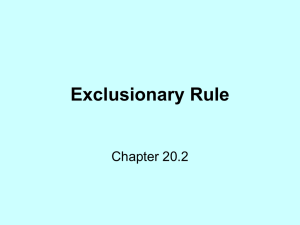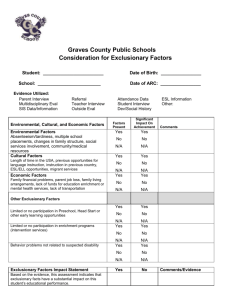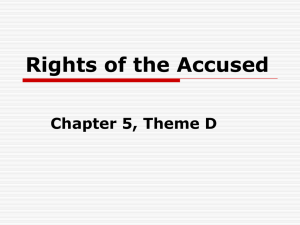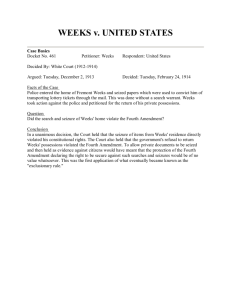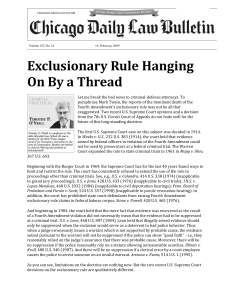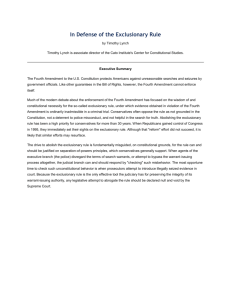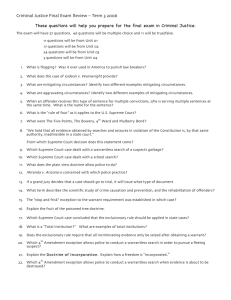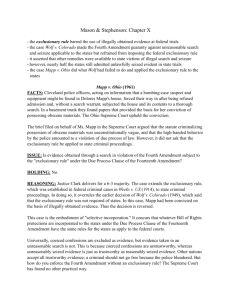Utah v. Strieff and the future of the exceptions to the exclusionary
advertisement
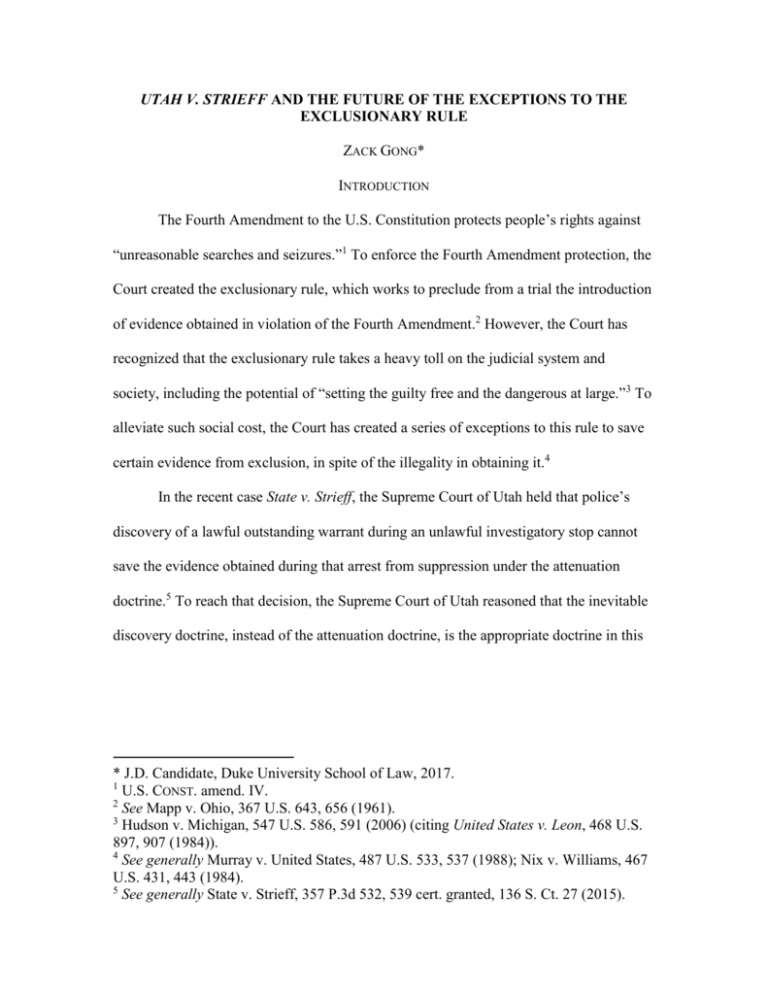
UTAH V. STRIEFF AND THE FUTURE OF THE EXCEPTIONS TO THE EXCLUSIONARY RULE ZACK GONG* INTRODUCTION The Fourth Amendment to the U.S. Constitution protects people’s rights against “unreasonable searches and seizures.”1 To enforce the Fourth Amendment protection, the Court created the exclusionary rule, which works to preclude from a trial the introduction of evidence obtained in violation of the Fourth Amendment.2 However, the Court has recognized that the exclusionary rule takes a heavy toll on the judicial system and society, including the potential of “setting the guilty free and the dangerous at large.”3 To alleviate such social cost, the Court has created a series of exceptions to this rule to save certain evidence from exclusion, in spite of the illegality in obtaining it.4 In the recent case State v. Strieff, the Supreme Court of Utah held that police’s discovery of a lawful outstanding warrant during an unlawful investigatory stop cannot save the evidence obtained during that arrest from suppression under the attenuation doctrine.5 To reach that decision, the Supreme Court of Utah reasoned that the inevitable discovery doctrine, instead of the attenuation doctrine, is the appropriate doctrine in this * J.D. Candidate, Duke University School of Law, 2017. 1 U.S. CONST. amend. IV. 2 See Mapp v. Ohio, 367 U.S. 643, 656 (1961). 3 Hudson v. Michigan, 547 U.S. 586, 591 (2006) (citing United States v. Leon, 468 U.S. 897, 907 (1984)). 4 See generally Murray v. United States, 487 U.S. 533, 537 (1988); Nix v. Williams, 467 U.S. 431, 443 (1984). 5 See generally State v. Strieff, 357 P.3d 532, 539 cert. granted, 136 S. Ct. 27 (2015). situation, but the court did not address whether the inevitable discovery doctrine can ultimately save the evidence from suppression.6 The theoretical foundation of how the Fourth Amendment guaranty gives rise to the exclusionary rule has never been rock solid; in fact, it is subject to constant academic debate.7 In light of the recent developments and expansions of the exception doctrines, some scholars even predicted the abolishment of the exclusionary rule.8 This commentary intends to articulate that given the Court’s policy justification for the exclusionary rule9 and the recent trend towards curbing its scope10, the Court is likely affirm the Supreme Court of Utah’s decision and further limit the application of the exclusionary rule. In Part II, I will line out the facts of this case; In Part III, I will discuss the legal background of the exclusionary rule leading up to this case; In Part IV, I will examine the Supreme Court of Utah’s holding and the reasoning behind it; and in Part V, I will provide my own analysis and prediction on how the Supreme Court will rule on this case. II. FACTS 6 Id. See generally Orin S. Kerr, An Equilibrium-Adjustment Theory of the Fourth Amendment, 125 Harv. L. Rev. 476, 478 (2011); Akhil Reed Amar, Fourth Amendment First Principles, 107 Harv. L. Rev. 757 (1994); Rhett DeHart, Is the Exclusionary Rule Doomed?, S.C. Law., March (2015); William C. Heffernan, On Justifying Fourth Amendment Exclusion, 1989 Wis. L. Rev. 1193 (1989). 7 8 See generally Herring v. New York, 422 U.S. 853 (1975); Matthew Allan Josephson, To Exclude or Not to Exclude: The Future of the Exclusionary Rule After Herring v. United States, 43 CREIGHTON L. REV. 175, 176 (2009) (citing No More Chipping Away: The Roberts Court Uses an Axe to Take Out the Fourth Amendment Exclusionary Rule, 81 Miss. L.J. 1183 (2012)); Rhett DeHart, Is the Exclusionary Rule Doomed?, S.C. LAW., March (2015); Candace C. Kilpinen, Herring v. United States: A Threat to Fourth Amendment Rights?, 44 VAL. U. L. REV. 747 (2010). Davis v. United States, 564 U.S. 229, 131 S. Ct. 2419, 2426 (2011) (“The rule's sole purpose, we have repeatedly held, is to deter future Fourth Amendment violations.”). 10 See generally Hudson v. Michigan, 547 U.S. 586, 586 (2006); Herring v. New York, 422 U.S. 853, 853 (1975); Davis v. United States, 564 U.S. 229 (2011). 9 In December 2006, Officer Douglas Fackrell picked up an anonymous drug tip reporting “narcotics activities” in a South Salt Lake City residence.11 Subsequently, Officer Fackrell initiated intermittent surveillance over the residence totaling three hours over the course of a week, during which he observed “short term traffic” at the residence, with visitors arriving and leaving within a few minutes.12 The traffic was not too frequent, but was more than that of a typical household and enough to raise the officer’s suspicion of ongoing drug sales activity.13 During the surveillance, Officer Fackrell saw defendant Edward Strieff leaving the residence and walking towards a convenience store.14 Although he did not see Strieff entering the residence, Officer Fackrell decided to “ask someone [to] find out what was going on [in] the house.”15 He confronted Strieff and ordered him to stop in a parking lot near the convenience store.16 After identifying himself and checking Strieff’s identification, Officer Fackrell asked dispatch to run a warrant check on Strieff, which revealed an outstanding traffic warrant.17 Pursuant to that warrant, Officer Fackrell arrested Strieff, searched him, and found a baggie of methamphetamine and drug paraphernalia in his pockets.18 Strieff was later charged with unlawful possession of methamphetamine and unlawful possession of drug paraphernalia.19 He moved to suppress that evidence and 11 State v. Strieff, 357 P.3d 532, 536 cert. granted, 136 S. Ct. 27 (2015). Id. 13 Id. 14 Id. 15 Id. 16 Id. 17 Id. 18 Id. 19 Id. at 537. 12 argued that it was the fruit of the initial investigatory stop, which was unlawful because the official lacked reasonable articulable suspicion—Officer Fackrell did not see Strieff entering the house, and thus did not know how long he stayed there or anything other than the fact that he left the house.20 The state conceded the unlawfulness of the stop, but argued that the evidence should nevertheless be admitted pursuant to the attenuation exception.21 The district court denied Strieff’s motion, reasoning that: (1) the surveillance had created reasonable suspicion for drug activity, and thus the stop “was to investigate a suspected drug house;” (2) the police officer’s conduct was not a flagrant violation of the Fourth Amendment but a good faith mistake; (3) weighing all evidence together, suppression of the evidence would be an “inappropriate remedy.”22 The Utah Court of Appeals affirmed the lower court’s decision on the ground that the discovery of a valid warrant is a powerful intervening circumstance that would dissipate the taint of the unlawful stop, and that the violation of the police officer was not flagrant or purposeful.23 III. LEGAL BACKGROUND The Fourth Amendment to the U.S. Constitution states: “The right of the people to be secure in their persons, houses, papers, and effects, against unreasonable searches and seizures, shall not be violated . . . .”24 In simple terms, the exclusionary rule dictates that evidence obtained in violation of the Constitution is in admissible in court. However, instead of being a constitutional mandate or personal right, the exclusionary rule is a 20 Id. Id. 22 Id. 23 See State v. Strieff, 286 P.3d 317 (Utah 2012). 24 U.S. CONST. amend. IV. 21 judicial remedy created by the Court to enforce the Fourth Amendment protection.25 In 1914, the Court held in Weeks v. United States that the exclusionary rule is enforceable in all federal courts.26 In Mapp v. Ohio, the Court held that the force of this rule is enforceable against the States by incorporating the Fourth Amendment into the liberties protected by the Fourteenth Amendment.27 The early cases on the exclusionary rule were not clear on its theoretical basis,28 and the rule has since been shrouded by heavy debate and criticism, with multiple scholars calling its jurisprudence a total mess.29 The justifications provided by the Court for the rule have changed over the years.30 Initially, the Court justified the rule in two ways: first, to “discourage[e] police misconduct” and second, as “the imperative of judicial integrity.”31 But in the following decades, through multiple hallmark cases, the 25 United States v. Calandra, 414 U.S. 338, 348 (1974); See also Arizona v. Evans, 514 U.S. 1, 10 (1995) (holding that the Constitution “contains no provision expressly precluding the use of evidence obtained in violation of its commands”). 26 Weeks v. United States, 232 U.S. 383 (1914). 27 Mapp v. Ohio, 367 U.S. 643, 656 (1961). 28 Potter Stewart, The Road to Mapp v. Ohio and Beyond: The Origins, Development and Future of the Exclusionary Rule in Search-and-Seizure Cases, 83 COLUM. L. REV. 1365, 1372 (1983) (“Unfortunately, the early cases fail to provide insight and guidance into the constitutional underpinnings for the exclusionary rule.”). 29 See generally Kit Kinports, Culpability, Deterrence, and the Exclusionary Rule, 21 WM. & MARY BILL RTS. J. 821 (2013) (“Academics and jurists of all stripes agree that the Court's case law in this area is a mess.”); Akhil Reed Amar, Fourth Amendment First Principles, 107 HARV. L. REV. 757, 757, 759 (1994); Roger B. Dworkin, Fact Style Adjudication and the Fourth Amendment: The Limits of Lawyering, 48 IND. L.J. 329, 329 (1973); Christopher Slobogin, Why Liberals Should Chuck the Exclusionary Rule, 1999 U. ILL. L. REV. 363, 375. 30 Josephson, supra note 9, at 179. 31 Id. Court has made clear that the sole justification for the exclusionary rule today is the deterrence of potential unconstitutional conduct from the law enforcement officers.32 Recognizing the undesirable effects of the exclusionary rule, the Court has developed a series of exceptions to its application when the deterrent value of the rule cannot be realized: (1) the independent source exception, (2) the inevitable discovery exception, and (3) the attenuation exception.33 The first two exceptions are closely related and they utilize a cause-in-fact analysis.34 Under the independent source doctrine, the taint on evidence that resulted from police misconduct will be dissipated if that same evidence is also obtained through another lawful method.35 Under the inevitable discovery doctrine, the tainted evidence will be admitted in court if it “ultimately or inevitably would have been discovered by lawful means even if no violation of any constitutional provision had taken place.”36 In these two scenarios, evidence has been or would have been discovered by separate lawful means, so the deterrent value of the rule is insufficient to justify its application. The third exception, the attenuation doctrine, shifts from a cause-in-fact analysis to a proximate cause analysis.37 It permits the admission of evidence discovered through police misconduct if the legal nexus between the misconduct and the evidence is United States v. Leon, 468 U.S. 897, 916 (1984) (“[T]he exclusionary rule is designed to deter police misconduct . . . .”); United States v. Calandra, 414 U.S. 338, 347 (1974) (“[T]he rule's prime purpose is to deter future unlawful police conduct . . . .”); 33 See generally Brent D. Stratton, The Attenuation Exception to the Exclusionary Rule: A Study in Attenuated Principal and Dissipated Logic, 75 J. CRIM. L. & CRIMINOLOGY 139 (1984). 34 State v. Strieff, 357 P.3d 532, 539 cert. granted, 136 S. Ct. 27 (2015). 35 Murray v. United States, 487 U.S. 533, 537 (1988). 36 Nix v. Williams, 467 U.S. 431, 432 (1984). 37 State v. Strieff, 357 P.3d at 540. 32 sufficiently attenuated.38 The logic of this doctrine was first elaborated and clarified in Wong Sun v. United States, in which the Court held that a defendant’s confession, made several days after the police’s unlawful invasion of his residence, was admissible because the connection between the misconduct and the confession had become sufficiently attenuated to dissipate the taint.39 The Court identified two key elements in Wong Sun: first, the government did not exploit the police wrongdoing to obtain the evidence and second, the confession worked as an intervening circumstance of free will.40 Later in Brown v. Illinois, the Court developed a three-factor test to determine whether attenuation doctrine is applicable: (1) the “temporal proximity” between the unlawful police conduct and the discovery of the evidence in question, (2) the existence of “intervening circumstances,” (3) the “purpose and flagrancy” of the official’s misconduct.41 A closer temporal proximity might indicate a bigger effect of the unlawful conduct on the collection of evidence and potential exploitation of the conduct by the police, and thus working in favor of suppression.42 An intervening circumstance is deemed to exist if it is “so distinct from the threshold Fourth Amendment violation that it can be said that the challenged evidence is not a product of “exploitation” of the illegality but instead the result of “ ‘means sufficiently distinguishable to be purged of the primary taint.’”43 And lastly, a purposeful and flagrant conduct is something “obviously improper” 38 See Stratton, supra note 33, at 142. See Wong Sun v. United States, 371 U.S. 471 (1963). 40 See Stratton, supra note 33, at 146. 41 State v. Strieff, 357 P.3d 532, 541 cert. granted, 136 S. Ct. 27 (2015) (citing Brown v. Illinois, 422 U.S. 590, 622 (1975)). 42 Id. 43 Id. (citing Wong Sun, 371 U.S. at 488). 39 and “investigatory in design and purpose and executed in the hope that something might turn up.”44 IV. HOLDING The issue in Utah v. Strieff is whether to apply the attenuation doctrine to the discovery of an outstanding arrest warrant and exempt the evidence obtained from the lawful arrest from suppression.45 According to the Supreme Court of Utah, all the attenuation doctrine cases so far have involved voluntary confession and the U.S. Supreme Court has never specifically decided the issue of this case.46 The Supreme Court of Utah delineated three general lines of reasoning adopted by lower courts on this issue.47 The first group of cases, exemplified by United States v. Green, holds that the discovery of a preexisting warrant is an intervening circumstance sufficient to purge the taint of the prior unlawful police conduct, given that the unlawful conduct itself is not flagrant.48 In reaching this conclusion, the Seventh Circuit emphasized whether the deterrent function of the exclusionary rule can be served: “application of the rule does not serve this deterrent function when the police action, although erroneous, was not undertaken in an effort to benefit the police at the expense of the suspect’s protected rights.”49 The court also cited Wong Sun v. United States, claiming that the evidence obtained from a lawful arrest pursuant to a preexisting warrant comes not “by exploitation of that illegality [but] by means sufficiently distinguishable to be purged of 44 Id. (citing United States v. Simpson, 439 F.3d 490, 496 (8th Cir.2006)). State v. Strieff, 357 P.3d 532, 535 cert. granted, 136 S. Ct. 27 (2015). 46 Id. 47 Id. 48 See United States v. Green, 111 F.3d 515, 522 (7th Cir. 1997). 49 Id. (citing United States v. Fazio, 914 F.2d 950, 958 (7th Cir. 1990)). 45 the primary taint.”50 Besides the Seventh Circuit, the Eighth Circuit and eleven state high courts have also adopted this rationale.51 The second group of cases applied the Brown v. Illinois test, but concluded that in the situation of a preexisting arrest warrant, the factors will result in non-application of the attenuation doctrine.52 In State v. Moralez, the court concluded that: (1) applying the first factor, the short time between the unlawful detention and the discovery of the warrant leads to a high temporal proximity, which “weighs heavily” against the application, (2) applying the third factor, the unlawful detention followed by a warrant search demonstrated some resemblance to an “investigatory detention designed and executed in the hope that something might turn up” and thus exhibit “at least some level of flagrant conduct.”53 The third line of reasoning, the one the Supreme Court of Utah adopted in this case, is to deem the attenuation doctrine inapplicable in the situation of a preexisting warrant.54 This rationale originated from the dissent opinion in State v. Frierson, in which Chief Justice Pariente proposed to limit the application of the attenuation doctrine to its original basis—situations involving a voluntary confession as a result of the independent acts of free will of the defendant, and thus excluding the preexisting warrant situation from consideration.55 50 Id. Petition for certiorari. 52 State v. Strieff, 357 P.3d 532, 543 cert. granted, 136 S. Ct. 27 (2015); Brown v. Illinois, 422 U.S. 590 (1975). 53 Id. (citing State v. Moralez, 300 P.3d 1090, 1103 (2013)). 54 Id. 55 Id. (citing State v. Frierson, 926 So.2d 1139 (Fla.2006) (Pariente, C.J., dissenting)). 51 The Supreme Court of Utah believed that the U.S. Supreme Court, through several seminal cases on attenuation doctrine—Brown, Wong Sun, Kaupp—indicated that the application of this doctrine is restricted to cases where the intervening cause is a voluntary confession of the defendant that breaks the legal proximate causation between the discovery of evidence and the initial police misconduct.56 The court provided two reasons to back up this claim: (1) the Brown factor test works to exclude a preexisting warrant situation from application—both the “temporal proximity” and the “purpose and flagrancy” factors focus on a proximate causation inquiry, and a warrant check is hardly an unforeseeable or superseding event after an unlawful detention; (2) the scenario of this case fits better with the doctrine of inevitable discovery, which covers evidence that will inevitably be discovered by a line of lawful police work separated from the unlawful detention—in this case, the execution of the legit warrant.57 And extending the coverage of attenuation doctrine will “eviscerate the inevitable discovery exception.”58 Thus, the Supreme Court of Utah reversed the lower court decision regarding the invocation of this doctrine.59 V. ANALYSIS Through a series of recent holdings, the U.S. Supreme Court’s jurisprudence on the exclusionary rule has been shifting towards narrowing and limiting its scope and 56 Id. State v. Strieff, 357 P.3d 532, 536 cert. granted, 136 S. Ct. 27, 192 L. Ed. 2d 997 (2015) (“. . . we deem the inevitable discovery doctrine to control.”). 58 State v. Strieff, 357 P.3d 532, 545 cert. granted, 136 S. Ct. 27 (2015). 59 Id. 57 power. Both Strieff and Utah have cited these seminal Supreme Court cases and considered their arguments in establishing their arguments.60 In Hudson v. Michigan, the Detroit police force violated the knock-and-announce rule—they announced their presence, but waited only “three to five seconds” before they broke into Hudson’s house, executing a legitimate search warrant on narcotics and weapons.61 Facing the issue of whether a violation of the knock-and-announce rule would result in the suppression of all the evidence obtained in the search, the Court, by a vote of 5-4, held that the exclusionary rule is not a proper remedy for a violation of the knockand-announce rule.62 In his majority opinion, Justice Scalia emphasized the point that the suppression of evidence “has always been our last resort, not our first impulse,” and that it shall only apply when its deterrence benefits outweigh its substantial social cost, including setting dangerous criminals free.63 Because “the value of deterrence depends upon the strength of the incentive to commit the forbidden act” and violating the knock-and-announce rule provides the police with little expected value, the deterrence value here is too little to justify the suppression of evidence.64 In Herring v. United States, a police officer arrested Herring based on a warrant in the neighboring county’s database, and a search incident to arrest revealed methamphetamine and an illegal pistol carried by Herring.65 However, it was later found See generally Brie for Petitioner; Respondent’s Brief in Opposition. Hudson v. Michigan, 547 U.S. 586, 586 (2006). 62 Id. 63 Id. 64 Id. 65 Herring v. New York, 422 U.S. 853 (1975). 60 61 out that, unbeknownst to the officer, the warrant had been recalled months earlier, which was not entered into the system due to a police mistake.66 The Supreme Court, by another 5-4 vote, ruled against the suppression of the evidence, reasoning that the police officer’s conduct in that case was not “sufficiently deliberate that exclusion can meaningfully deter it, [or] sufficiently culpable that such deterrence is worth the price paid by the justice system.”67 The Court laid out the exclusionary rule as a remedy reserved for “deliberate, reckless, or grossly negligent conduct, or in some circumstances recurring or systemic negligence,” and concluded that the simple negligence mistake cannot be remedied by suppression of evidence.68 The Herring rationale was further confirmed by another case, Davis v. United States.69 In Davis, the police arrested Willie Davis during a routine vehicle stop for giving a false name, and in the search of Davis’s car incident to arrest, the police found an illegal weapon.70 The police search of the vehicle complied with relevant appellate precedent at the time, but as Davis appealed his case to the Circuit Court of Appeals, the U.S. Supreme Court announced a new rule governing searches of vehicles incident to arrests of recent occupants in Arizona v. Gant,71 which made the police search of Davis’s car illegal.72 Because the police officer in Davis was neither negligent nor culpable and thus there was no meaningful deterrent effect from suppressing the evidence, the U.S. 66 Id. Id. at 144. 68 Id. 69 See generally Davis v. United States, 564 U.S. 229, 131 S. Ct. 2419, 2426 (2011). 70 Id. 71 Arizona v. Gant, 556 U.S. 332 (2009). 72 Davis,131 S. Ct. at 2426. 67 Supreme Court, by a vote of 7-2, held that the exclusionary rule was not applicable.73 There, the Court continued to stress how rare the exclusionary rule should be applied and how a good faith or simple, isolated mistake of the police should not result in suppression of evidence found.74 Applying the rational of the above cases to the Utah v. Shrieff, the answer seems clear. The mistake Officer Fackrell made in this case was a non-systemic, non-recurring mistake. Prior to the stoppage, the Officer had the house under surveillance for a week, and observed sufficient short-term traffic to believe that he had enough evidence to establish reasonable suspicion about potential drug activities.75 Although this belief was later held to be incorrect, the Officer was merely one fact short from having a sufficient legal basis to stop Shrieff: he did not see Shrieff entering the residence under surveillance.76 As the district court held, such a misjudgment with minimal culpability by the officer is a “good faith mistake on the part of the officer as to the quantum of evidence needed to justify an investigatory detention,”77 and by any standard, the Court should not characterize such an action as “deliberate, reckless, or grossly negligent.”78 Thus, the exclusionary rule should not be the proper remedy. Moreover, above-described line of cases limiting the application of the exclusionary rule triggered discussion about the future of the exclusionary rule and possible abolishment of it,79 especially when the very justification of the exclusionary 73 Id. Id. 75 Id. 76 State v. Strieff, 357 P.3d 532, 536–37 cert. granted, 136 S. Ct. 27 (2015). 77 Id. at 535. 78 Davis v. United States, 564 U.S. 229, 131 S. Ct. 2419, 2427 (2011). 79 See generally Dehart, supra note 8. 74 rule—its deterrent effect on police misconduct—can hardly be empirically proven and subject to heated debate. On the flip side, studies have shown that the imposition of such rules actually increased crime rate.80 With questionable efficacy of the current, ex post remedies, scholars have started to propose that more attention be placed on the alternative, ex ante prevention of Fourth Amendment violations.81 Overall, it seems that the reasons for which the exclusionary rule was originally created have already expired—the U.S. police force today has taken people’s constitutional rights more seriously and generally obeys the Fourth amendment requirement,82 and the ubiquitous coverage of mass media has also served to deter police misconduct. Thus, it is likely that the Court will continue to limit the application of the exclusionary rule by reversing the decision of the Supreme Court of Utah. CONCLUSION Since its creation, the exclusionary rule, an ex post remedy deterring police violation of the Fourth Amendment, has been subject to controversy due to its uncertain legal foundation and questionable effectiveness. In the past decade, the Supreme Court has navigated the Fourth Amendment jurisprudence towards a much more limited application of the exclusionary rule, applying it only to those cases where the police misconduct was deliberate, reckless, or grossly negligent. Thus, applying such a rationale 80 See Albert W. Alschuler, Studying the Exclusionary Rule: An Empirical Classic, 75 U. CHI. L. REV. 1365, 1383 (2008) (“. . . the imposition of the exclusionary rule increased violent crimes by 27 percent and property crimes by 20 percent.”). 81 See generally Oren Bar-Gill, Barry Friedman, Taking Warrants Seriously, 106 NW. U. L. REV. 1609 (2012) (arguing that a serious ex ante warrant requirement will be much clearer and more effective than a deterrence model); But See David A. Harris, How Accountability-Based Policing Can Reinforce-or Replace-the Fourth Amendment Exclusionary Rule, 7 OHIO ST. J. CRIM. L. 149 (2009) (arguing that criminology studies have shown that the exclusionary rule still possesses its unique deterrence value). 82 Hudson, 547 U.S. at 599. to the facts in Utah v. Strieff, the Supreme Court is very likely to consider Officer Fackrell’s misconduct to be a good-faith misjudgment, and decide that the exclusionary rule is not a proper remedy for it.
